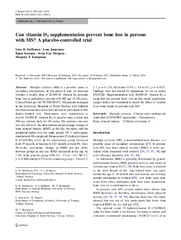| dc.contributor.advisor | Kampman, Margitta | |
| dc.contributor.author | Steffensen, Linn Hofsøy | |
| dc.date.accessioned | 2013-01-08T10:36:16Z | |
| dc.date.available | 2013-01-08T10:36:16Z | |
| dc.date.issued | 2012-12-13 | |
| dc.description.abstract | In persons with Multiple sclerosis (MS) low bone mineral density (BMD) is more prevalent when compared with healthy controls and MS may be a possible cause of secondary osteoporosis. BMD is primarily determined by genetic and hormonal factors, body mass index, physical activity and intake of calcium and vitamin D. Vitamin D level at 50 nmol/L or higher is classified as sufficient, however, optimal vitamin D level for bone health is according to many experts at least 75 nmol/L. In this 96 week randomized controlled clinical trial, we aimed to asses whether a weekly dose of 20,000 IU vitamin D3 could prevent bone loss in fully ambulatory persons with MS age 18-50 years. 71 persons with MS where randomized to receive either a weekly dose of 20,000 IU vitamin D3 or placebo. Half of the study participants had sufficient winter vitamin D levels (50 nmol/l) at study start and the level was strongly predicted by sun exposure through sun vacation or solarium and by vitamin D intake. All participants in the vitamin D group achieved sufficient winter vitamin D levels and levels of 75 nmol/L or higher were achieved by 91% of the participants. BMD was lower than expected in 25% of the participants at screening and BMD at the hip decreased by 1% in the whole study population. There was no significant difference between the groups. Several studies have shown that in persons with MS, BMD decreases as disability increasingly limits physical activity and progressing physical handicap also increases the risk of falls and fractures. Even though this small study could not prove any effect of vitamin D supplementation on BMD loss, intake of vitamin D is an important factor in preventing osteoporosis. In order to achieve adequate vitamin D levels, MS patients who have no vitamin D efficient sun exposure and low dietary vitamin D intake during the winter months should take vitamin D supplements. | en |
| dc.description.doctoraltype | ph.d. | en |
| dc.description.popularabstract | 71 unge gangføre personer med MS fikk enten høydose vitamin D eller placebo i 96 uker. Vi gjennomførte beintetthets- og vitamin D målinger, fysiske tester og deltagerne besvarte spørreskjemaer. Ved studiestart om vinteren hadde halvparten tilfredsstillende vitamin D nivåer, sjansen økte betraktelig ved solarium eller solferie og jevnlig vitamin D tilskudd. Alle som fikk vitamin D oppnådde tilfredsstillende vinternivåer. Beintetthet var lavere enn forventet hos 25 % ved studiestart. Gjennomsnittlig beintap i hele gruppen var 1 %, noe som ikke er forventet hos jevnaldrende friske. Høydose vitamin D stoppet ikke beintapet.
Personer med MS har økt risiko for lav beintetthet. Økende handikap kan bidra til beinskjørhet og risikoen for fall og brudd tiltar og beintetthetsmålinger bør utføres. Denne studien fant ikke at vitamin D hindret beintap, men vitamin D i anbefalte doser er viktig ved forebygging av beinskjørhet. MS pasienter som ikke utsettes for sollys og med lavt vitamin D inntak i vintermånedene bør ta vitamin D tilskudd. | en |
| dc.description.sponsorship | Thanks to the University of Tromsø, the Research Council of Norway and Odd Fellows Research Foundation for Multiple Sclerosis which the study has received financial support from. | en |
| dc.description | Papers 1 and 3 of this thesis are not available in Munin: <br/>1. Steffensen LH, Mellgren SI and Kampman MT: 'Predictors and prevalence of low bone
mineral density in fully ambulatory persons with multiple sclerosis', Journal of Neurology (2010), vol. 257(3):410-418. Available at <a href=http://dx.doi.org/10.1007/s00415-009-5337-6>http://dx.doi.org/10.1007/s00415-009-5337-6</a> <br/> Steffensen LH, Mellgren SI and Kampman MT: 'Erratum to: Predictors and prevalence of low bone mineral density in fully ambulatory persons with multiple sclerosis', Journal of Neurology (2010), vol. 257(3):497-498. Available at <a href=http://dx.doi.org/10.1007/s00415-010-5470-2>http://dx.doi.org/10.1007/s00415-010-5470-2</a> <br/>3. Steffensen L.H, Brustad M and Kampman M.T.: 'What is needed to keep persons with multiple sclerosis vitamin D-sufficient throughout the year?', Journal of Neurology (2013), vol. 260(1):182-188. Available at <a href=http://dx.doi.org/10.1007/s00415-012-6611-6>http://dx.doi.org/10.1007/s00415-012-6611-6</a> | en |
| dc.identifier.isbn | 978-82-7589-376-3 | |
| dc.identifier.uri | https://hdl.handle.net/10037/4740 | |
| dc.identifier.urn | URN:NBN:no-uit_munin_4454 | |
| dc.language.iso | eng | en |
| dc.rights.accessRights | openAccess | |
| dc.rights.holder | Copyright 2012 The Author(s) | |
| dc.rights.uri | https://creativecommons.org/licenses/by-nc-sa/3.0 | en_US |
| dc.rights | Attribution-NonCommercial-ShareAlike 3.0 Unported (CC BY-NC-SA 3.0) | en_US |
| dc.subject | VDP::Medisinske Fag: 700::Klinisk medisinske fag: 750::Nevrologi: 752 | en |
| dc.subject | MS | en |
| dc.subject | Vitamin D | en |
| dc.subject | Osteoporose | en |
| dc.title | Can vitamin D3 supplementation prevent bone loss in persons with MS? | en |
| dc.type | Doctoral thesis | en |
| dc.type | Doktorgradsavhandling | en |


 English
English norsk
norsk

